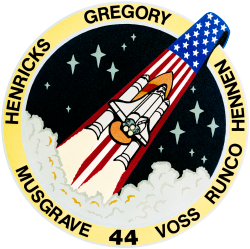Mario Runco
| Mario Runco | |
|---|---|
 Mario Runco | |
| Astronaut NASA | |
| Státní příslušnost | |
| Datum narození | 26. ledna 1952 (71 let) |
| Místo narození | New York, New York |
| Hodnost | kapitán |
| Čas ve vesmíru | 22 dní, 23 hodin a 8 minut |
| Kosmonaut od | 1987 |
| Mise | STS-44, STS-54, STS-77 |
| Znaky misí | |
| Pozdější zaměstnání | důchodce |
| Některá data mohou pocházet z datové položky. | |
Mario Runco (*26. ledna 1952 v New Yorku, stát New York, USA), meteorolog, důstojník a americký astronaut. Ve vesmíru byl třikrát.
Život
Studium a zaměstnání
V roce 1970 zdárně ukončil střední školu Cardinal Hayes High School v Bronxu (New York) a pak pokračoval dalším studiem na City College of New York, obory meteorologie, fyzika oceánografie. To ukončil v roce 1974 a pak pokračoval ve studiu meteorologie na Rutgers University v Novém Brunšviku. Dostudoval v roce 1976.
Pracoval na několika místech, od roku 1978 byl v armádě.
V letech 1987 až 1988 absolvoval výcvik u NASA, od roku 1988 byl zařazen do jednotky kosmonautů.
Oženil se, s manželkou Susan, rozenou Friessová má dvě děti.
Lety do vesmíru
Na oběžnou dráhu se v raketoplánech dostal třikrát a strávil ve vesmíru 22 dní, 23 hodin a 8 minut. Byl 280 člověkem ve vesmíru. Absolvoval jeden výstup do kosmu (EVA) v délce 4,5 hodiny.
- STS-44 Atlantis (24. listopadu 1991 – 1. prosince 1991)
- STS-54 Endeavour (13. leden 1993 – 19. leden 1993)
- STS-77 Endeavour (19. květen 1996 – 29. květen 1996)
Odkazy
Externí odkazy
 Obrázky, zvuky či videa k tématu Mario Runco na Wikimedia Commons
Obrázky, zvuky či videa k tématu Mario Runco na Wikimedia Commons - Na webu Space
- Na webu MEK-Kosmo
Média použitá na této stránce
The STS-77 crew patch displays the Shuttle Endeavour in the lower left and its reflection within the tripod and concave parabolic mirror of the SPARTAN Inflatable Antenna Experiment (IAE). The center leg of the tripod also delineates the top of the Spacehab's shape, the rest of which is outlined in gold just inside the red perimeter. The Spacehab was carried in the payload bay and housed the Commercial Float Zone Furnace (CFZF). Also depicted within the confines of the IAE mirror are the mission's rendezvous operations with the Passive Aerodynamically-Stabilized Magnetically-Damped satellite (PAM/STU) appears as a bright six-pointed star-like reflection of the sun on the edge of the mirror with Endeavour in position to track it. The sunlight on the mirror's edge, which also appears as an orbital sunset, is located over Goddard Space Flight Center, the development facility for the SPARTAN/IAE and Technology Experiments Advancing Missions in Space (TEAMS) experiments. The reflection of the Earth is oriented to show the individual countries of the crew as well as the ocean which Captain Cook explored in the original Endeavour. The mission number 77 is featured as twin stylized chevrons and an orbiting satellite as adapted from NASA's logo. The stars at the top are arranged as seen in the northern sky in the vicinity of the constellation Ursa Minor. The field of 11 stars represents both the TEAMS cluster of experiments (the four antennae of GPS Attitude and Navigation Experiment (GANE), the single canister of Liquid Metal Thermal Experiment (LMTE), the three canisters of Vented Tank Resupply Experiment (VTRE), and the three canisters of PAM/STU) and the 11th flight of Endeavour. The constellation at the right shows the fourth flight of Spacehab Experiments.
STS-54 Mission Insignia
portrait astronaut Mario Runco
STS-44 Mission Insignia




